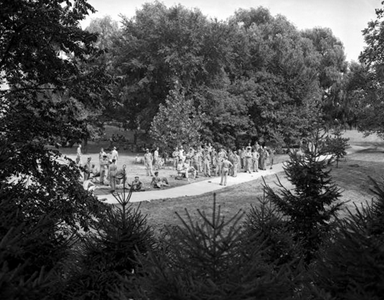Army Specialized Training Program (ASTP) Soldiers in quarantine from polio on IU Bloomington campus in August 1943. Photo courtesy Indiana University Archives.
By: Richard L. Schreiner, M.D.
Chairman, Riley Hospital Historic Preservation Committee
Edwin L. Gresham Professor Emeritus of Pediatrics, IUSM
Retired Chairman, Department of Pediatrics, IUSM
Retired Physician-in-Chief, Riley Hospital for Children at IU Health
You’re in your first year out as a physician and get handed full responsibility for managing an epidemic crisis. Would you be ready? One Indiana University School of Medicine resident was.
Dr. Margaret Ann Bassett, (MD ’42, IUSM and a member of the 1942-43 resident and intern staff of the Indiana University Medical Center), was serving as a university physician at the Student Health Center at Indiana University Bloomington. Three hundred army men of a detachment which arrived at Indiana University Bloomington from California on August 18, 1943, were placed under quarantine the next day as a safeguard against the spread of poliomyelitis (polio).
At that time, officials believed the two cases of polio already reported would be the only ones.
Both Dr. Thurman B. Rice, IUSM professor of public health and then Commissioner of the State Board of Health, and Dr. Lyman.T. Meiks, (Riley Hospital’s first full-time pediatrician, 1931-51, and first full-time chairman of the IUSM Department of Pediatrics, 1951-1967), who was recognized as an authority on polio, agreed, that “there is no reason to believe the cases will spread and few if any more cases are expected.” My best guess is that Dr. Meiks imparted his knowledge about polio to Dr. Bassett during her time as a medical student, knowledge that helped her when she needed to act quickly and decisively.
The soldiers were transferred from California to Indiana University for specialized army training courses, according to an army statement, and both cases of infantile paralysis were discovered on the train en route to Bloomington. One man was taken to a hospital in the West and the other removed to the I.U. Medical Center at Indianapolis. The army said it believed both men had contracted the illness in California.
Since Dr. Edith Boyer Schuman (IUSM MD ‘33 and first IUSM female intern, ‘33), Head of the University Health Center, was away from campus at that time, it was Dr. Margaret Ann Bassett who was handed full responsibility over the infantile paralysis epidemic, when 15 ASTP (Army Specialized Training Program) soldiers came down with cases of polio. She had 65 soldiers under observation at the height of the epidemic and supervised checking twice daily of 400 others, successfully keeping the panic on campus under control.
Months later, one accounting of her actions recognized that University officials and the Army not to mention several hundred ASTP cadets, will long be thankful for Dr. Margaret Ann Bassett, characterized by her colleagues as “the little dynamo with a sense of humor.”
Dr. Bassett, an outstanding IUSM graduate and member of Alpha Omega Alpha, national medical honorary, was praised highly by Dr. Schuman. “I know of no one,” said Dr Schuman, “who could have completely and satisfactorily managed the epidemic and controlled the panic among the men as she did.”
Dr. Bassett completed 2 years of service as a physician at the Indiana University Health Center in Bloomington and military installations there. She then returned to her hometown of Thorntown where her father, Dr. Clancy Bassett had practiced medicine and she did, too, for 32 years. She also served on the staff at Witham Memorial Hospital in Lebanon. Dr. Bassett died on January 27, 1986.
All physicians get tested throughout their medical careers and, some, like Dr. Bassett, very early in their career. All IUSM students, residents, and interns can look to her example for inspiration, knowing that when the moment comes to test what you know and can do, you can and will rise to the occasion with grace, courage, and confidence.
